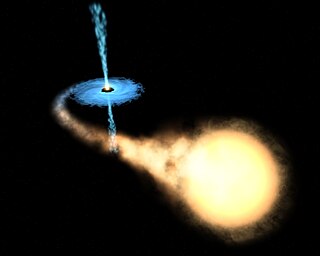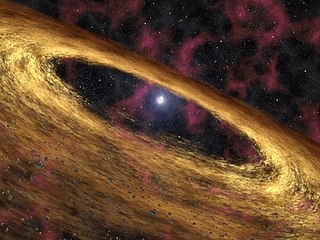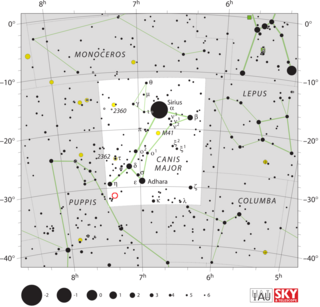Related Research Articles

A neutron star is the collapsed core of a massive supergiant star, which had a total mass of between 10 and 25 solar masses (M☉), possibly more if the star was especially metal-rich. Except for black holes, neutron stars are the smallest and densest currently known class of stellar objects. Neutron stars have a radius on the order of 10 kilometres (6 mi) and a mass of about 1.4 M☉. They result from the supernova explosion of a massive star, combined with gravitational collapse, that compresses the core past white dwarf star density to that of atomic nuclei.

X-ray binaries are a class of binary stars that are luminous in X-rays. The X-rays are produced by matter falling from one component, called the donor, to the other component, called the accretor, which is very compact: a neutron star or black hole. The infalling matter releases gravitational potential energy, up to several tenths of its rest mass, as X-rays. The lifetime and the mass-transfer rate in an X-ray binary depends on the evolutionary status of the donor star, the mass ratio between the stellar components, and their orbital separation.

ROSAT was a German Aerospace Center-led satellite X-ray telescope, with instruments built by West Germany, the United Kingdom and the United States. It was launched on 1 June 1990, on a Delta II rocket from Cape Canaveral, on what was initially designed as an 18-month mission, with provision for up to five years of operation. ROSAT operated for over eight years, finally shutting down on 12 February 1999.

Geminga is a gamma ray and x-ray pulsar source thought to be a neutron star approximately 250 parsecs from the Sun in the constellation Gemini.

An ultraluminous X-ray source (ULX) is an astronomical source of X-rays that is less luminous than an active galactic nucleus but is more consistently luminous than any known stellar process (over 1039 erg/s, or 1032 watts), assuming that it radiates isotropically (the same in all directions). Typically there is about one ULX per galaxy in galaxies which host them, but some galaxies contain many. The Milky Way has not been shown to contain a ULX, although SS 433 may be a possible source. The main interest in ULXs stems from their luminosity exceeding the Eddington luminosity of neutron stars and even stellar black holes. It is not known what powers ULXs; models include beamed emission of stellar mass objects, accreting intermediate-mass black holes, and super-Eddington emission.

IC 443 is a galactic supernova remnant (SNR) in the constellation Gemini. On the plane of the sky, it is located near the star Eta Geminorum. Its distance is roughly 5,000 light years from Earth.

4U 0142+61 is a magnetar at an approximate distance of 13000 light-years from Earth, located in the constellation Cassiopeia.

A radio-quiet neutron star is a neutron star that does not seem to emit radio emissions, but is still visible to Earth through electromagnetic radiation at other parts of the spectrum, particularly X-rays and gamma rays.

HM Cancri (also known as HM Cnc or RX J0806.3+1527) is a binary star system about 1,600 light-years (490 pc; 1.5×1016 km) away. It comprises two dense white dwarfs orbiting each other once every 5.4 minutes, at an estimated distance of only 80,000 kilometres (50,000 mi) apart (about 1/5 the distance between the Earth and the Moon). The two stars orbit each other at speeds in excess of 400 kilometres per second (890,000 mph). The stars are estimated to be about half as massive as the Sun. Like typical white dwarfs, they are extremely dense, being composed of degenerate matter, and so have radii on the order of the Earth's radius. Astronomers believe that the two stars will eventually merge, based on data from many X-ray satellites, such as Chandra X-Ray Observatory, XMM-Newton and the Swift Gamma-Ray Burst Mission. These data show that the orbital period of the two stars is steadily decreasing at a rate of 1.2 milliseconds per year as they thus are getting closer by approximately 60 centimetres (2.0 ft) per day. At this rate, they can be expected to merge in approximately 340,000 years. With a revolution period of 5.4 minutes, HM Cancri is the shortest orbital period binary white dwarf system currently known.
In astronomy, Calvera is a nickname —based on the villain in the 1960 film The Magnificent Seven— of an X-ray source known as 1RXS J141256.0+792204 in the ROSAT All-Sky Survey Bright Source Catalog (RASS/BSC). It lies in the constellation Ursa Minor and is identified as an isolated neutron star. It is one of the closest of its kind to Earth. There is a ring of radio emission almost a degree in diameter, offset about 4′.9 from Calvera itself, which is possibly its supernova remnant.
A luminous supersoft X-ray source is an astronomical source that emits only low energy X-rays. Soft X-rays have energies in the 0.09 to 2.5 keV range, whereas hard X-rays are in the 1–20 keV range. SSSs emit few or no photons with energies above 1 keV, and most have effective temperature below 100 eV. This means that the radiation they emit is highly ionizing and is readily absorbed by the interstellar medium. Most SSSs within our own galaxy are hidden by interstellar absorption in the galactic disk. They are readily evident in external galaxies, with ~10 found in the Magellanic Clouds and at least 15 seen in M31.
The Magnificent Seven is the informal name of a group of isolated young cooling neutron stars at a distance of 120 to 500 parsecs from Earth. These objects are also known under the names XDINS or simply XINS.
1RXS J160929.1−210524 is a pre-main-sequence star approximately 456 light-years away in the constellation of Scorpius.

Astrophysical X-ray sources are astronomical objects with physical properties which result in the emission of X-rays.

The history of X-ray astronomy begins in the 1920s, with interest in short wave communications for the U.S. Navy. This was soon followed by extensive study of the earth's ionosphere. By 1927, interest in the detection of X-ray and ultraviolet (UV) radiation at high altitudes inspired researchers to launch Goddard's rockets into the upper atmosphere to support theoretical studies and data gathering. The first successful rocket flight equipped with instrumentation able to detect solar ultraviolet radiation occurred in 1946. X-ray solar studies began in 1949. By 1973 a solar instrument package orbited on Skylab providing significant solar data.

The Chamaeleon complex is a large star forming region (SFR) at the surface of the Local Bubble that includes the Chamaeleon I, Chamaeleon II, and Chamaeleon III dark clouds. It occupies nearly all of the constellation Chamaeleon and overlaps into Apus, Musca, Carina and Octans. The mean density of X-ray sources is about one source per square degree.

AZ Cancri (AZ Cnc) is a M-type flare star in the constellation Cancer. It has an apparent visual magnitude of approximately 17.59.

Hakkı Boran Ögelman was a Turkish physicist and astrophysicist. He was an expert on gamma ray astronomy, the physics of neutron stars, and solar energy and worked on several key topics in modern astrophysics. He made many contributions to high energy astrophysics. In his early professional career he engaged in the SAS-II Small Gamma Ray Astronomy Satellite experiment development, data analysis, and first detection and imaging of our universe in gamma rays with his NASA colleagues, as well as in other fields of physics. His main interests in the field of astrophysics were the study of gamma ray astronomy and compact objects such as neutron stars and pulsars. Ögelman worked at NASA Goddard Space Flight Center, Middle East Technical University (METU) in Ankara, Turkey, Çukurova University in Adana, Turkey, Max Planck Institute (MPI) at Garching, Germany and the University of Wisconsin.

RX J0720.4−3125 is a neutron star in the constellation Canis Major. It was discovered in 1997 in the ROSAT All-sky survey. Measurement of its parallax leads to an estimate of around 360 parsecs for its distance from Earth. It is a member of the Magnificent Seven, a group of neutron stars that are relatively near to the Solar System. RX J0720.4–3125 has a radius of around 5 km. Its spectrum and temperature appear to be mysteriously changing over several years. The nature of the changes are unclear, but it is possible there was an event such as the star's absorption of an accretion disc.
References
- ↑ David L. Kaplan (2004). The Diversity of Neutron Stars: Nearby Thermally Emitting Neutron Stars and the Compact Central Objects in Supernova Remnants. Universal-Publishers. p. 237. ISBN 978-1-58112-234-3.